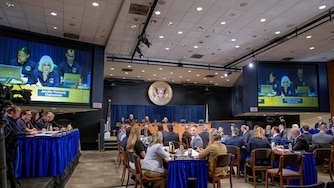Kevin Gomer filed into the MARC commuter train hours before the sun came up, three meals packed, listless not from lack of sleep, but rather from the stress of workplace uncertainty that awaited.
His procurement work at the National Institutes of Health was mostly paused as the Elon Musk-led Department of Government Efficiency, or DOGE, slashes federal spending. But new in-office policies meant he would carry out his lighter workload that day from behind a desk in suburban Montgomery County.
“DOGE and the government dictate my life now,” he said during the commute one March morning. His refrain throughout the nearly three-hour morning trip: “This isn’t sustainable.”
With four, 10-hour in-office days that week, Gomer’s total commute time added up to 20 hours. Nearly a full day, zapped.
The Baltimore-D.C. commuter, once endangered, is in species-recovery mode.
Roughly 100,000 federal workers live in the Baltimore metro region. The Trump administration’s return-to-office demand has clogged interstates and crowded commuter trains at levels not seen since before the COVID-19 pandemic changed the way many desk jobs are done.
The Baltimore Banner interviewed dozens of area federal workers, even commuting with Gomer, to capture their new reality. Many asked for anonymity out of fear of retaliation by the administration.
Some have found unexpected silver linings in office work, even joy in early morning drives. Most are dismayed by lost time with family, or new financial burdens that come with child care or buying a car.
Gomer’s trek that day required leaving his Patterson Park home around 4:30 a.m. to catch an hourlong southbound MARC train in West Baltimore. Then he waded through crowds at Union Station to jump on a Metro Red Line that made an hour journey northwest to the Twinbrook station.
A drive, two trains and a short walk. The sunrise created a purple glow on the horizon as he made his final approach to the office.
“I’m literally the walking dead,” said Gomer, waiting to cross an intersection.
Read More
Bottlenecks and beltways
Gridlock and carbon emissions are so back.
Hybrid and work-from-home schedules popularized during the pandemic created a modern-day respite from the perpetual traffic around and between Baltimore and Washington, D.C. — the area’s highways have long been a hot mess of pavement, brake lights and burning fuel.
Between Inauguration Day and March 24, peak-hour congestion was worse on Interstates 95, 295, 495 and 695, as well as US-29, than during the same period for the previous three years, according to State Highway Administration data.
For A., a federal worker who asked to be identified by her first initial, the best way to avoid the worst traffic is to leave her South Baltimore home at 5 a.m. and arrive at the office for a roughly 6:15 a.m. clock-in.
That’s a big change from working 8 a.m. to 4:30 p.m. at home. That had been her schedule since taking the job in the middle of the pandemic.
The drive home can take as long as two hours, A. said. The most frustrating patch is just south of Baltimore, a bottleneck that has tightened since the collapse of the Francis Scott Key Bridge cut off one of three Patapsco River crossings.
“I don’t think I was doing any worse of a job before,” she said. “We do the same things, have the same conversations.”
Days in the office do facilitate quicker answers on projects from coworkers, A. said, but her job reviewing contracts hasn’t substantively changed.
A. said a long daily commute means less sleep and a lot more coffee. It means less time for everything, including household chores and time with her spouse and friends.
“I don’t really do anything after work anymore,” she said.
Another federal worker, who asked to be identified as L., said his day isn’t impacted quite as much by the return of commuting — in part because his drive starts in East Baltimore and ends in a Maryland suburb instead of D.C.
He worked a hybrid schedule until this year, which he said made sense because some meetings were more productive in person. But not all.
“Largely, you’re on [Microsoft] Teams meetings in the office with people in their offices, so it makes virtually no sense to be in the office,” L. said. “There’s not a whole lot of collaborating in the office, or not as much as some Boomers may think.”
One silver lining: L. said he notices more people leaving their laptops in the office at the end of the day, suggesting a harder wall between work and personal lives.
One Baltimore-area federal worker who now rises at 3:30 a.m. to start the day said he loves driving and actually looks forward to the long commute.
For others, like a federal worker who asked to be identified as K., the slog means a whole list of new financial considerations.
K.’s family, a spouse and three children, has just one car, a choice made out of financial and environmental considerations. With K. — and the family car — now gone all day, her spouse bought an e-bike for local errands and transporting the kids to school.
“Prices of everything have been going up lately, and we’re already really tight,” K. said.
Now add gas and tolls. The family is considering taking one of the kids out of a private school to save money.
The family also had to adjust to K. not being around as much. K. laments not being able to make it to as many school events or make dinner as often.
Hitting the MARC
Steve Choi has been commuting on a MARC train from Baltimore to his federal job in D.C. for more than 40 years.
He has been on the day’s first train through all its phases, including when it was packed “wall-to-wall” before the pandemic and the days since, when he could pick just about any seat he wanted.
On a recent March morning, Choi’s train was standing-room-only once again — the first time he’d noticed it since pre-pandemic.
The commuter rail line has had something of an identity crisis in recent years. Weekday trains were roughly only half-full, according to the MTA. But with fewer trains on the weekends and more interest in social train travel, there were at times no seats Saturdays and Sundays.
Things have changed since Trump returned to the White House. At the end of February, the MTA reported its largest single-day MARC ridership in nearly five years.
Between January and February, ridership grew by 10%. Then it rose 47% in March. Though the rider count is still far below 2019 levels, it’s more than double what it was three years ago, according to MTA data.
Choi, a member of a MARC riders advisory council, said that all three lines have seen ridership increases this year.
Train life comes with challenges. MARC shares track space with Amtrak and CSX, companies that own the rails between Baltimore and D.C. — when MARC trains run late, it’s often because Amtrak or CSX trains got in the way.
Just last week, some MARC Penn Line riders were left waiting hours after a stretch of overhead catenary wire, which powers the electric trains, lost its juice.
Stations are close to population and work centers, but not always convenient for everyone.
A., the federal worker who lives in South Baltimore, has been trying some train commuting but found that it makes the days even longer. Like Gomer, she has to drive to the station or get her partner to drop her off, and a Metro ride awaits on the other end.
One of the “benefits” of public transit over driving is the ability to work during the commute. Chunks of this story were written from the MARC train, despite the lack of power outlets (that’s a hint, MTA).
But for federal workers required to be at their desks to carry out their duties, a long train commute can feel like a giant waste of time.
It did for Gomer, whose journey that March morning stretched another half-hour thanks to Metro maintenance issues.
Gomer’s long commuting days ended abruptly last week: A federal worker for more than a decade, he lost his job as part of the DOGE sweep of health agencies.





Comments
Welcome to The Banner's subscriber-only commenting community. Please review our community guidelines.